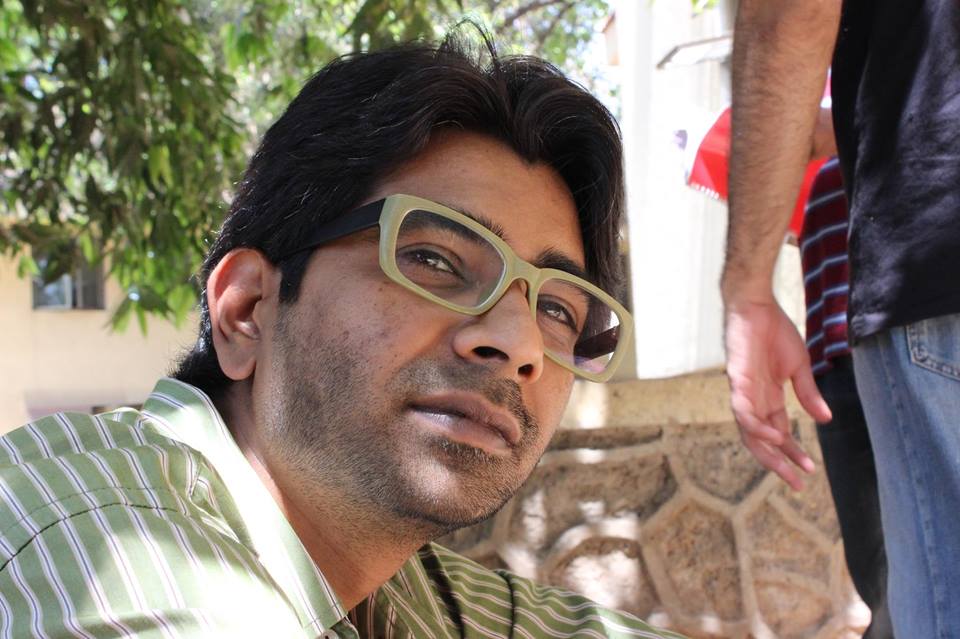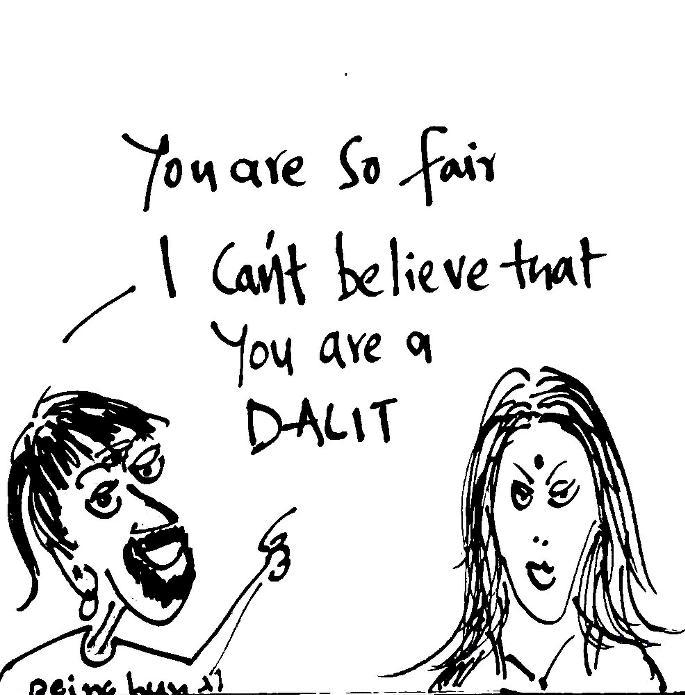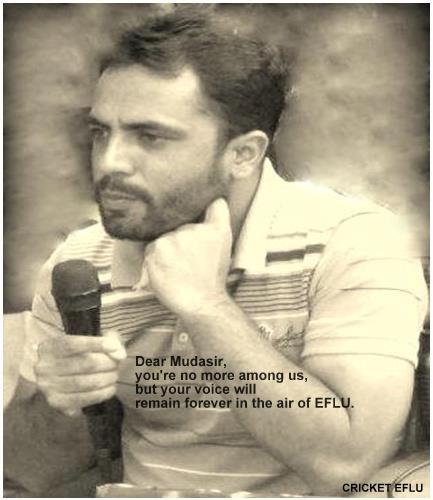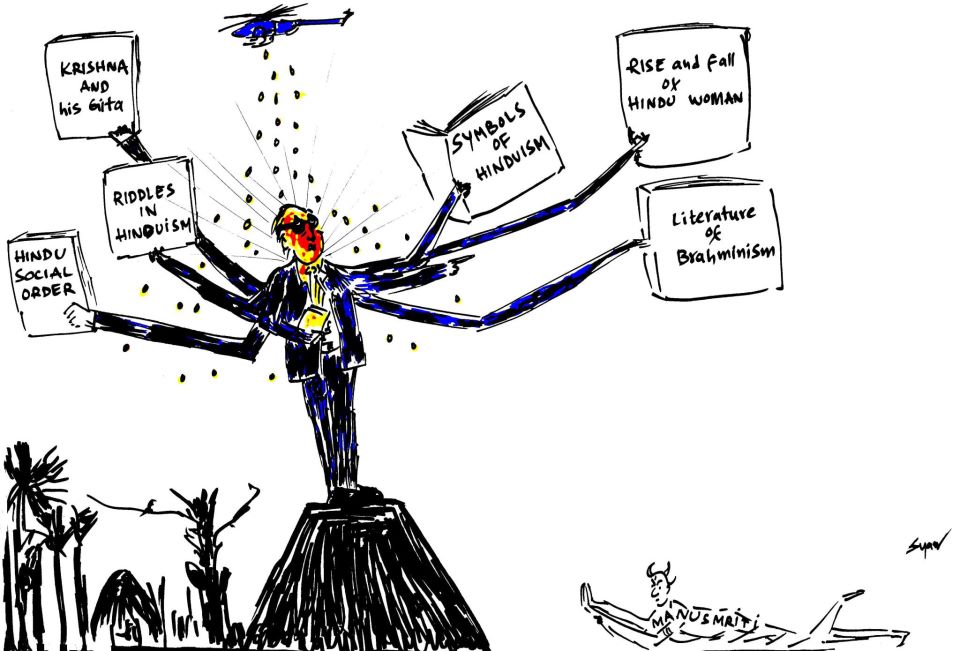Nilesh Kumar
 The effect of caste on the ethics of the Hindus is simply deplorable. Caste has killed public spirit. Caste has destroyed the sense of public charity. Caste has made public spirit impossible. A Hindu’s public is his caste. His responsibility is only to his caste. His loyalty is restricted only to his caste. Virtue has become caste-ridden and morality has become, caste-bound. There is no sympathy to the deserving. There is no appreciation of the meritorious. There is no charity to the needy. Suffering as such calls for no response. There is charity but begins with the caste and ends with the caste. There is sympathy but not for men of other caste.
The effect of caste on the ethics of the Hindus is simply deplorable. Caste has killed public spirit. Caste has destroyed the sense of public charity. Caste has made public spirit impossible. A Hindu’s public is his caste. His responsibility is only to his caste. His loyalty is restricted only to his caste. Virtue has become caste-ridden and morality has become, caste-bound. There is no sympathy to the deserving. There is no appreciation of the meritorious. There is no charity to the needy. Suffering as such calls for no response. There is charity but begins with the caste and ends with the caste. There is sympathy but not for men of other caste.
~ Dr. Babasaheb Ambedkar, Annihilation of Caste.
Babasaheb’s words from Annihilation of Caste clearly delineate the behavioral psyche of the caste Hindus of the country whose social, economic and political associations are all derived and decided by his or her caste. The Constitution has created rights for the citizen, but it did not eradicate the caste from their hearts and minds, so for the majority caste is a habit of heart and it is a habit of the hierarchical society at large. Even our constitutional pillars of the ‘biggest democracy in the world’: judiciary, legislature, executive and press are caste ridden. Let me cite a few examples to explicate what I am trying to say here. A small survey can tell us the missing numbers of Dalit, Adivasis and Muslims holding positions in all the four pillars. These spaces are largely hegemonised by elite- upper caste-class sections of the society. In the following exposition, I will talk about the state of the Indian judiciary, apart from the unconstitutional existence of Khap Panchayats.
Dalit, Adivasi & Muslim Undertrial Prisoners
Indian judiciary today has become corrupt and prejudiced. A recent media report reveals the shocking figure that 53 per cent of all undertrial prisoners are Dalits, Adivasis and Muslims1. According to the report, the proportion of these three communities in India adds up to about 39 per cent, but their share in the prison population is considerably higher than that. According to the Prison Statistics India, 2013, 22 per cent of convicts are Dalits, that is nearly one among every four convicts, while their proportion in population is about 17 percent. Muslim convicts are nearly 20 percent, with a 13 percent population share. Adivasis are 11 percent, while their share in the general population is around 8.6 percent. These inmates remain in prison because of proliferating prejudices. There is no study which says that Dalit, Adivasis and Muslims are the only communities that commit crimes and others don’t. The reality is because of the lower social economic and political capital that inmates from marginalized communities find it difficult to fight their legal battles, pay for bail, hire a lawyer or get decent free legal aid service. They are also targeted falsely in many cases leading to acquittal after having languished in prisons for several years2. How can one ever compensate for the years lost in the prisons and the hardship suffered by them and their families?
Custodial Deaths of Dalits, Adivasis & Muslims
Besides the large number of Dalit, Adivasi and Muslim undertrial prisoners, another shocking factor is the custodial deaths of undertrials in either police or judicial custody. Nearly 12,000 persons have died and 3,532 cases of custodial torture are reported either in jails or in police stations in past five years3. Asian Centre for Human Rights4 (ACHR) stresses that 99.99 per cent of deaths in custody occur because of torture, denial of medical facilities and inhuman prison conditions and degrading treatment. State-wise cases of deaths in police custody from 2001-2011 reveal that Maharashtra has recorded the highest number with 250 deaths in police custody. While in the state-wise cases of death in jails, Uttar Pradesh reports the highest number of deaths at 2,171.
Capital Punishment and Dalit, Adivasis, OBCs and Muslims
Anup Surendranath, Assistant Professor of the National Law University, Delhi 5, conducted an empirical study which reveals that, of the over 400 interviews taken during the research study of the prisoners on death row, majority were from backward, Dalit and Muslim communities. Most of these convicts were actually first-time offenders and were convicted on the basis of confessions taken under duress which are inadmissible as evidence in the court of law. The study reveals that over 80 percent of them are tortured and tutored by the police and most significantly, they are invariably poor. Inhuman treatment meted out to these prisoners and the pitiable quality of legal assistance provided to them adds to their misery. These impoverished inmates are even denied the required time of interaction with their lawyers. They get labeled as criminals by the courts without being heard. It becomes clear from the study that the criminal justice system works differently for different people.
Surinder Koli6, who was given death penalty for one of the 15 infamous cases of Nithari murders in Noida, Uttar Pradesh, had allegedly confessed that he killed 16 children and a woman. Police says that Koli allegedly confessed to his crime. The only evidence against Koli till now is his confession to the magistrate under Section 164 of the Criminal Procedure Code (CrPC) where he reported what he told the police. But what went unreported is the fact that Koli had told his lawyers that he was tortured before his confession. Koli also mentions that the magistrate failed to notice the signs of torture inflicted on him, made very clear by the fact that his fingernails and toenails were missing. The confessional statement of Koli was recorded in English language which is unknown to him. For the longest period of time, Koli was not provided legal aid, which according to the Supreme Court is a ‘sacrosanct right’ of the accused. Koli worked at Moninder Singh Pandher’s house. Next to Pandher’s residence lived a doctor, who was booked in an organ trafficking racket years ago. However, this angle was never investigated in Koli’s case. Presently Koli’s mercy petition is pending before Allahabad HC. Flimsy circumstantial evidence and the police’s attempt to suppress evidence point to the possible organ trading racket which pushes one to think that the entire case against Koli could be fabricated. If the noose were to be tightened around Koli’s neck, what happens to the remaining 15 murder charges slapped against him?
In Bihar’s Bara district massacre of 36 Bhumihars (upper castes) on February 12, 1992; all of them were allegedly killed by a Maoist squad. The squad comprised of three Dalits- Krishna Mochi, Veer Kunwar Paswan, Nanhelal Mochi and one Rajput, Dharmendra Singh. All of them were sentenced to death. The draconian Terrorist and Disruptive Activities (TADA) Act was invoked in this case, which never gets applied when Dalits are massacred. Although the four belonged to impoverished background, their assertion and demand for their rights and dignity cost them dearly.
In Bihar’s Bhagalpur jail, out of the 36 awarded death sentence, 35 belong to Dalit, OBCs and Muslims. Veteran journalist Prabhat Kumar Shandilya following this judgment has said that there seems to be a hundred percent reservation for Dalits and poor and marginalized in capital punishment. No upper caste culprit has ever been sent to the gallows after Independence, with the only exceptions of Nathuram Godse and Narayan Apte, the killers of Mahatama Gandhi, and of Dhananjoy Chatterjee, a lift man hanged in 2004 after being held guilty for raping and murdering a minor in West Bengal. There were several others. But they escaped the noose on appeal. Kuffir7 a frequent blogger and an anti-caste activist writes, “Nice to know that there’s at least one public institution in India that doesn’t worry about dilution of merit”.
Though I am an ardent believer of the fundamental right to life and am against the death penalty, I still will point at the glaring lopsided justice system which saves those from elite castes involved in gruesome offences from death penalty. But for similar crimes of murder, the court levels the doctrine of “rarest of rare” crimes against the Dalits.
Criminality and Caste: an inversely proportionate phenomenon
The most recent figures of atrocities against Dalits indicate that there were 32,569 acts of violence against Dalits and most of these were gruesome and horrendous in nature. Apart from many of these reported cases, there are also a large number of cases which go unreported and never reach courts. The cases which reach court also go unrequited with justice; some of the major cases, although chilling, fail to shake the conscience of the nation.
Take for instance, the Bathani Tola8 and the Laxmanpur Bathe9 massacres of 1996 and 1997 respectively, where a private Hindutva militant group called Ranvir Sena (composed mostly of Bhumihars) killed some 21 (in Bathani Tola) and 58 (in Laxmanpur Bathe) Dalit villagers. Amongst the victims were many infants, children, teenage girls and pregnant women. Former president late Dr. K.R. Narayanan called the massacres a ‘national shame’. In a third incidence that unfolded in Shankarbigha10, 24 Dalits were shot on 25th January 1999. They rained bullets indiscriminately on Dalits and later set their huts on fire. In this carnage, 22 people were killed on the spot and 14 others were seriously injured.
In the Laxmanpur Bathe case11, the lower court awarded capital punishment to 16 Bhumihar attackers and the rest were sentenced to life imprisonment. However, when the case came up for confirmation of death sentence before the Bihar High Court all 26 accused where acquitted for “lack of evidences” and the witnesses were declared “unreliable”.
In Bathani Tola12, 23 accused were convicted for the massacre, by the Ara Sessions Court in 2010. But in April 2012, the Bihar High Court acquitted all the accused by refusing to accept the statements of the survivors and stated “they would have died had they witnessed the massacre”. In Shankarbigha massacre, the court acquitted all 24 accused named in the case for want of evidence.
On 22nd September 1992, in Bhateri village of Rajasthan state, Bhanwari Devi13 who belonged to the Kumhar (potter) caste was gang raped by five men of Gujjar caste. The case finally reached the court in which the judge acquitted all the five rapists, stating inter alia that, “Bhanwari’s husband couldn’t have passively watched his wife being gang-raped.” The judge disgracefully stated that, “since the offenders were upper caste men and included a Brahmin, the rape could not have taken place because Bhanwari is from lower caste.”
Haryana state has become the rape capital with an increase in rape and atrocity cases against Dalits. A number of incidences of rape, excommunication and violence have been reported in Haryana. Four Dalit girls from the Dhanuk caste were abducted and raped by Jat boys for two days in Bhagana village14 of Hissar. These minor girls aged 13-18 years worked for upper caste landowners. They bore the brunt of Jat ire following a social boycott imposed by the Khap Panchayat against the Dhanuks, forcing nearly 400 displaced Dalit families to leave their homes and flee the village. Some 90 Dalit families are still squatting at Jantar Mantar and protesting since 16th April 2014. Their demands include arrest of the village head and his son Gajraj, whose name was not included in First Information Report (FIR), along with the rehabilitation of victims’ families. Another Dharna of 120 Dalit families is also waiting at the Hissar Collectorate office for the past two years.
In the Mirchpur massacre15, houses belonging to people from the Valmiki caste were attacked and burnt by Jats on April 19, 2010. In this incident, 70 year old Tara Chand and his physically challenged daughter Suman were burnt alive. While the girl died in the house instantly, Tara Chand died in hospital after giving his dying declaration. As many as 51 persons belonging to the Valmiki community suffered severe injuries and their properties were burnt. Large scale rioting and looting took place. The police were reportedly involved in the massacre.
The court held only 15 of 97 Jats guilty of various criminal acts including murder16. Another 12 were convicted for milder charges. Apart from these two incidences, there are many such incidences of rape and murder in Haryana where Dalit women have become a part of the hurting statistics – two cases of atrocities are observed every day.
In Dharmapuri district of Tamil Nadu17 more than 268 houses of three Dalit colonies were burnt following the suicide of the father of a Vanniyar (dominant caste) girl who had fallen with a Dalit boy and married him. Although there was no reported casualty, threat to life forced the Dalits to flee from these colonies. A year later, the boy was allegedly found dead near a railway track18. Like Bihar, Tamil Nadu too has a gruesome history of violence against Dalits starting with the bloody killing of 42 Dalit laborers in Kilvenmani, Thanjavur district, in 1968. Most of the perpetrators in this crime also went unpunished.
In Andhra Pradesh’s Karamchedu massacre of 17th July 198519, more than 2,000 Kammas armed with axes and lathis barbarically hacked and killed Madigas and Malas of Madigapalli. Women were molested, their blouses were torn and three young women were raped and speared. Houses were destroyed, money was stolen, roof-tiles were pulled down and holes were made in the mud walls. In Tsunduru (or Chunduru)20 on August 6, 1991, Reddys, a dominant caste of Andhra, killed nine Dalits and at least nine others were reported missing with several other Dalits injured. It was perhaps another big killing in the history of India.
In the Khairlanji killings21, in Bhandara district of Maharashtra, which provoked nationwide protests by Dalits, four persons of a family were brutally assaulted, raped and killed by the upper caste Maratha villagers. The autopsy of the bodies was done in the poorest manner. There were no efforts to test the bodies of the two females for rape though they were found naked with deep wounds on their private parts, in the canal. The case was also poorly represented in the court. Out of 33 people first booked, only 11 people were convicted for murder by the trial court. But rape charges were not invoked and charges under atrocity act were rejected. Bombay High Court termed it as resulting from ‘personal rivalry‘ and ‘individual revenge‘.
Saurav Datta22, who teaches media and jurisprudence in Mumbai and Pune, argues, “Shockingly, the court went to considerable lengths to hold that because there was no evidence, no rape had been committed – completely ignoring the harsh reality – that there would be no witnesses, and that the trial court had committed a glaring omission by ignoring evident facts. If the naked and badly mangled bodies of Dalit women did not stir the court to acknowledge sexual atrocity, perhaps nothing else could have.” Maharashtra has also seen other gruesome genocides against Dalits during Dr. Babasaheb Ambedkar Marathwada Naamvistar movement (1978-94). In these 16 years of struggle, many Dalits were brutally killed, tortured and women raped. Incidents of arson, poisoning of wells and excommunication were also reported across Marathwada.
In the gut wrenching murder case of Up-Sarpanch Pochiram Kamble, his hands and legs was hacked and he was burnt alive by persons belonging to Maratha and Kunbi communities. While the culprits bayed for his blood, Kamble continued to cantillate Jai Bhim. More than 25 people were martyred for the cause of Namantar. But none of these murderers were sent to the prison or prosecuted for their crimes.
In Ghatkopar’s Ramabai firing of July 11 199723, as many as 10 innocent Dalits were shot dead and 26 people were seriously injured by the police. The cop, Manohar Kadam, who ordered the firing and lathi charge on the protesters, was given life imprisonment in 2009 only to have his sentence suspended by the Bombay High Court later.

In the recent past, Ahmednagar district has witnessed heart wrenching incidents of hacking and murdering of Dalit men who dared to love women outside their castes. The perpetrators involved in most of the crimes are left scot free.
In Kambalapalli village near Chintamani in Kolar district of Karnataka state, seven Dalits were burnt alive24 in their house by upper caste mob on the evening of March 11, 2000. Later the trial court acquitted all 46 persons named in this case25. Apparently, this is not the only incidence of caste atrocities in Kolar district. A Dalit boy was killed in the village for matriculating with distinction, while an upper caste boy from the same village had failed. The accused here too were acquitted because of ‘lack of evidence.’
Judicial Prejudice
It begins from improper filing of First Information Report (FIR) against the upper caste culprits, poor medical examination, shoddy investigation and using improper charges in the chargsheet by the police.
The final hope is always tied to the courts. But it is our courts where Dalits, Adivasis and Muslims face disappointments. From this existing state of the justice delivery system, controlled totally by the upper castes, Dalits, Adivasis and Muslims will never be allowed to obtain their rights. The Indian criminal justice system has consistently failed to help the Dalits, Adivasis and Muslims in getting justice. This is due to the blind approach of the justice system in recognizing communal and caste or caste-based violence. Their wisdom lies in non-acceptance of caste.
It becomes necessary to ask why in a multicultural, multi-religious and diverse country Dalit, Adivasis and Muslims remain disproportionately represented in Indian prisons? I think the reasons can be either flawed justice system or poverty- struck inmates prefer to staying inside the prisons. After all, the fundamental right to food and shelter gets protected inside the prisons. It’s an irony that one has to commit a crime to access his rights to shelter and food. Whatever it may be, these facts show that something is fundamentally wrong with the justice system of this country.
Our judiciary is not bereft of caste. Babasaheb says that in Hindu society virtue has become caste-ridden, and morality has become caste-bound – has judges’ morality become caste-bound? Caste prejudices are becoming very important in operation and existence of our criminal justice system. It is due to caste, class and religious inequities that increasing number of Dalits, Adivasis and Muslims have their fates sealed inside the four walls of prisons.
Dalits, Adivasis and Muslims face police as well as judicial brutality, women population also get sexually violated due to deeply entrenched caste and communal bias. Indian courts have failed consistently to acknowledge that the sexual violence against women of these communities are perpetuated because of caste and communal biases.
Friend, blogger, lawyer and activist Karthik Navayan questions the caste arrogance of Indian judiciary. He asserts, “If Madras High Court had punished the criminals in Kilvenmani, Dharmapuri, if Andhra Pradesh High Court had punished the criminals in Tsunduru, Karamchedu Dalit massacres, if Karnataka High Court had punished criminals in Kambalapalli, if Bihar High Court had punished the criminals in Baithani Tola, Laxmanpur Bathe, it would have created fear of law among the oppressive caste killers. But releasing these criminals who killed Dalits, in today’s context, seems like our judiciary is encouraging Dalit killings.”
PS: In citing just Dalit atrocities cases, the author is nowhere trying to undermine the brutalities faced by the Adivasis and Muslims and injustice meted out to them.
(Special thanks to Sukanya Shantha for providing the case details, cleaning the copy and making it more readable)
References
1. http://www.thehindu.com/news/national/twothirds-of-prison-inmates-in-india-are-undertrials/article6545617.ece
2. http://indianexpress.com/article/news-archive/web/tagged-as-victims-but-accused-of-rioting-they-get-relief-after-14-yrs-2/99/
3. http://timesofindia.indiatimes.com/india/11820-custodial-deaths-in-five-years/articleshow/26283098.cms
4. http://www.achrweb.org/reports/india/torture2011.pdf
5. http://www.outlookindia.com/article/Most-Death-Row-Convicts-Are-Poor/292798
&
http://www.outlookindia.com/article/The-Daily-Noose/292796
6. http://www.tehelka.com/nithari-killing-hanging-surinder-kohli-will-bury-the-truth/
7. kufr.blogspot.in/2009/01/hundred-percent-reservation-in-capital.html
8. http://roundtableindia.co.in/index.php?option=com_content&view=article&id=5252:the-warriors-who-slayed-babies-and-other-tales&catid=119:feature&Itemid=132
&
http://roundtableindia.co.in/index.php?option=com_content&view=article&id=6937:from-khailanji-to-haryana-do-dalits-have-human-rights-2&catid=119:feature&Itemid=132
9. http://roundtableindia.co.in/index.php?option=com_content&view=article&id=5206:ranvir-sena-massacres-and-state-complicity&catid=122:atrocities&Itemid=138
&
http://roundtableindia.co.in/index.php?option=com_content&view=article&id=7393:brahmanical-courts-and-the-death-of-justice&catid=119:feature&Itemid=132
10. http://timesofindia.indiatimes.com/india/16-yrs-on-all-Shankarbigha-carnage-accused-acquitted/articleshow/45877277.cms
11. http://www.firstpost.com/politics/laxmanpur-bathe-massacre-no-one-killed-58-dalits-1166975.html
12. http://www.thehindu.com/news/cities/Delhi/justice-for-bathani-tola-massacre-victims-demanded/article3644998.ece
13. http://www.thebetterindia.com/7199/the-irony-of-iconhood-the-life-and-times-of-bhanwari-devi/
14. http://roundtableindia.co.in/index.php?option=com_content&view=article&id=7461:bhagana-haryana-rape-victims-warn-hudda-against-inaction&catid=129&Itemid=195
&
http://roundtableindia.co.in/index.php?option=com_content&view=article&id=7507:bhagana-laboratory-of-dalit-atrocities-and-resistance&catid=119:feature&Itemid=132
15. http://roundtableindia.co.in/index.php?option=com_content&view=article&id=4686:mirchpur-carnage-against-dalits&catid=122:atrocities&Itemid=138
16. http://www.hrln.org/hrln/dalit-rights/pils-a-cases/757-mirchpur-case-a-landmark-judgement-for-dalit.html
17. http://roundtableindia.co.in/index.php?option=com_content&view=article&id=6052:fact-finding-teams-report-on-dharmapuri-caste-pillage&catid=122:atrocities&Itemid=138
&
http://www.firstpost.com/politics/dharmapuri-violence-why-dalits-are-unsafe-in-dravidian-tamil-nadu-522135.html
18. http://roundtableindia.co.in/index.php?option=com_content&view=article&id=6723:who-killed-ilavarasan&catid=119:feature&Itemid=132
19. http://roundtableindia.co.in/index.php?option=com_content&view=article&id=3450:history-of-karamchedu-and-what-actually-happened&catid=118:thought&Itemid=131
&
http://roundtableindia.co.in/index.php?option=com_content&view=article&id=3450:history-of-karamchedu-and-what-actually-happened&catid=118:thought&Itemid=131
20. http://karthiknavayan.files.wordpress.com/2014/04/tsunduru-carnage-apclc-report-published-in-august-1991-apclc.pdf
&
http://roundtableindia.co.in/index.php?option=com_content&view=article&id=7401:following-tsundur-taking-stock-of-path-to-justice&catid=119:feature&Itemid=132
&
http://roundtableindia.co.in/index.php?option=com_content&view=article&id=5972:duddu-prabhakar-dalit-movement-at-a-crossroads&catid=119:feature&Itemid=132
&
http://roundtableindia.co.in/index.php?option=com_content&view=article&id=7411:the-whole-system-is-in-their-hands-including-the-judicial-system-bojja-tharakam&catid=119:feature&Itemid=132
21. http://roundtableindia.co.in/index.php?option=com_content&view=article&id=7302:khairlanji-gruesome-massacre-of-dalits-dalit-fury-scorches-maharashtra&catid=122:atrocities&Itemid=138
22. http://www.aljazeera.com/indepth/opinion/2014/06/india-courts-condone-dalit-rape-201461010327959421.html
23. http://roundtableindia.co.in/index.php?option=com_content&view=article&id=6727:the-ramabai-killings&catid=122:atrocities&Itemid=138
24. http://roundtableindia.co.in/index.php?option=com_content&view=article&id=7605:kambalapalli-carnage&catid=122:atrocities&Itemid=138
25. http://www.thehindu.com/todays-paper/acquittal-of-kambalapalli-accused-a-setback-to-dalits/article3030316.ece
~~~
Nilesh Kumar is a Ph.D researcher in Tata Institute of Social Sciences, Mumbai, and his main interest is to document the narratives and experiences of discrimination which Dalit students face while pursuing Higher Education.
Cartoon by Unnamati Syama Sundar.










